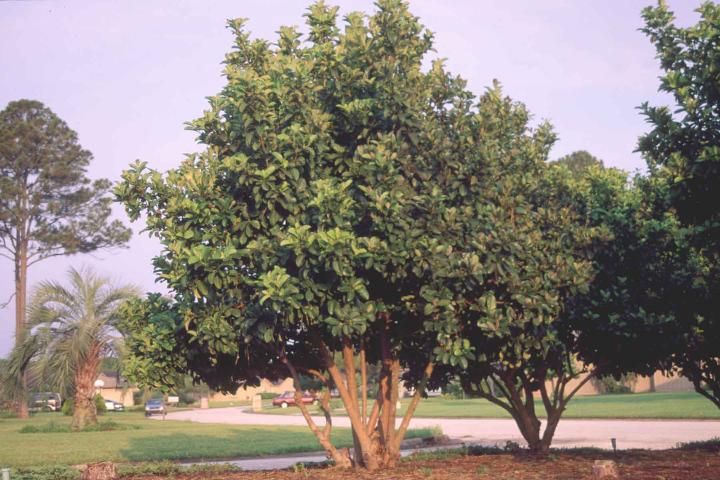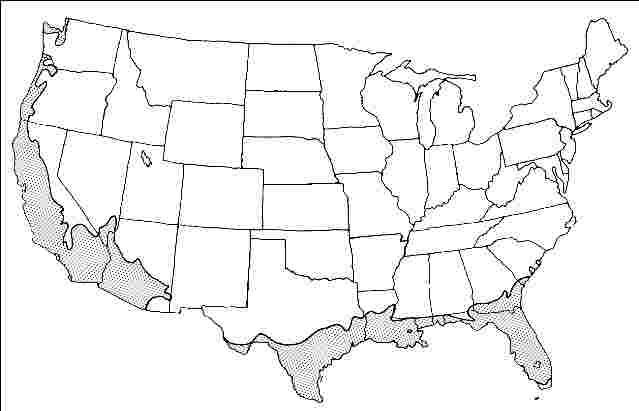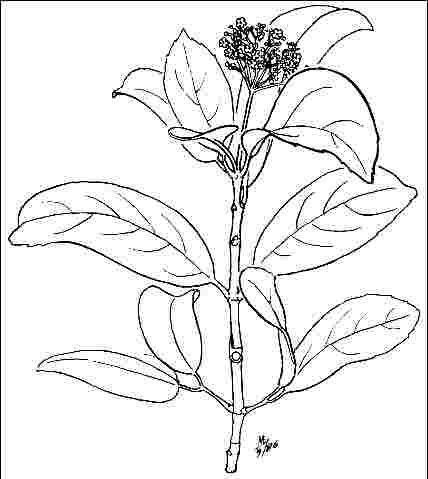Introduction
Large, leathery, dark green, glossy leaves and clusters of extremely fragrant, small, white flowers, completely covering the plant in springtime, make Sweet Viburnum a longtime landscape favorite. The large, dull green leaves form a moderately coarse texture. For some reason, it has fallen out of favor as a small tree in recent years. This adaptable tree should be `rediscovered' by landscape architects and others specifying small trees for urban and suburban landscapes. Often used as a screen or clipped hedge, its dense, spreading, evergreen habit makes Sweet Viburnum suitable for use as a small tree, reaching 25 to 30 feet tall and wide at maturity, with a dense, multibranched, rounded canopy. The flowers are often followed by small, red berries which turn black when ripe and are moderately showy.

Credit: Ed Gilman
General Information
Scientific name: Viburnum odoratissimum
Pronunciation: vye-BER-num oh-duh-ruh-TISS-ih-mum
Common name(s): Sweet Viburnum
Family: Caprifoliaceae
USDA hardiness zones: 8B through 10A (Fig. 2)
Origin: not native to North America
Invasive potential: has been evaluated using the IFAS Assessment of the Status of Non-Native Plants in Florida's Natural Areas (UF/IFAS 2018). This species is not documented in any undisturbed natural areas in Florida. Thus, it is not considered a problem species and may be used in Florida
Uses: screen; deck or patio; hedge; container or planter; specimen; street without sidewalk; parking lot island < 100 sq ft; parking lot island 100-200 sq ft; parking lot island > 200 sq ft; sidewalk cutout (tree pit); tree lawn 3-4 feet wide; tree lawn 4-6 feet wide; tree lawn > 6 ft wide; urban tolerant; highway median; shade
Availability: somewhat available, may have to go out of the region to find the tree

Description
Height: 25 to 30 feet
Spread: 15 to 25 feet
Crown uniformity: symmetrical
Crown shape: round
Crown density: dense
Growth rate: slow
Texture: medium
Foliage
Leaf arrangement: opposite/subopposite (Fig. 3)
Leaf type: simple
Leaf margin: serrate, entire
Leaf shape: elliptic (oval)
Leaf venation: pinnate
Leaf type and persistence: evergreen, broadleaf evergreen
Leaf blade length: 2 to 4 inches, 4 to 8 inches
Leaf color: green
Fall color: no color change
Fall characteristic: not showy

Flower
Flower color: white/cream/gray
Flower characteristics: showy
Fruit
Fruit shape: round
Fruit length: less than .5 inch
Fruit covering: fleshy
Fruit color: red, black
Fruit characteristics: does not attract wildlife; not showy; fruit/leaves not a litter problem
Trunk and Branches
Trunk/bark/branches: branches don't droop; not showy; typically multi-trunked; thorns
Pruning requirement: needed for strong structure
Breakage: resistant
Current year twig color: green
Current year twig thickness: thick
Wood specific gravity: unknown
Culture
Light requirement: full sun, partial sun or partial shade, shade tolerant
Soil tolerances: clay; sand; loam; alkaline; acidic; well-drained
Drought tolerance: high
Aerosol salt tolerance: low
Other
Roots: not a problem
Winter interest: no
Outstanding tree: no
Ozone sensitivity: unknown
Verticillium wilt susceptibility: susceptible
Pest resistance: resistant to pests/diseases
Use and Management
Sweet Viburnum grows quickly in full sun or partial shade on a wide variety of soils. It is tolerant to drought, holding up very well in unirrigated landscapes once established. Relatively maintenance-free, Sweet Viburnum grown as a tree will require pruning to control size and shape. A nice, neat, compact canopy develops without any training. Interior sprouts and branches need to be removed to make the trunk show. Only lower branches need removal to allow for pedestrian and vehicle clearance beneath the crown. This would be a good tree for planting along a street where power lines or other obstructions limit overhead space. Nurseries should be encouraged to grow this adaptable plant as a tree form in addition to the shrub form commonly available. It can be trained to one trunk or grown as a multi-stemmed specimen.
The cultivar `Emerald Lustre' has larger leaves and `Nanum' is a dwarf form. Viburnum odoratissimum var. awabuki has large glossy leaves and flower panicles, and beautiful red berries.
Propagation is by cuttings or layerings.
Pests
This tree is usually fairly pest-free.
Viburnum aphid is gray to dark green and feeds in clusters at the tips of the branches, causing leaf curl. The insects can be dislodged with high pressure water spray from the garden hose. They usually cause little or no appreciable damage.
Inspect the stems of unhealthy-looking plants for possible scale infestations. If found, spray with horticultural oil for some control.
Sweet Viburnum is also infested by thrips, mites, white-fly, bagworms, and sooty mold, but none are normally serious.
Diseases
Bacterial leafspot causes round, water-soaked spots on leaves and young stems. These develop into shrunken, brown areas about 1/8-inch in diameter. Destroy infected leaves.
Bacterial crown gall forms galls on the lower stems. Do not replant in the same spot.
Shoot blight causes grayish to brown decayed spots on the leaves. The spots first appear at the leaf margins, then spread to the rest of the leaf. Infected flower clusters or twigs are killed.
A number of fungi cause leaf spots. Leaf spots are not usually serious diseases. Rake up and destroy infected leaves, if you wish.
Downy mildew and powdery mildew cause a white powdery growth on the leaves but usually cause only cosmetic damage of little consequence.
Literature Cited
Fox, A.M., D.R. Gordon, J.A. Dusky, L. Tyson, and R.K. Stocker (2005) IFAS Assessment of the Status of Non-Native Plants in Florida's Natural Areas. Cited from the Internet (November 3, 2006), http://plants.ifas.ufl.edu/assessment.html